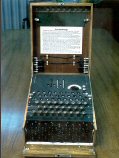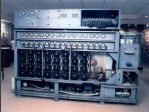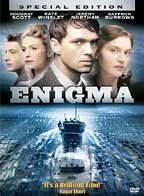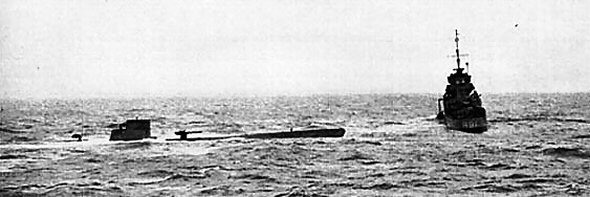|

The Enigma machine began life in 1923 as a commercial product produced by a German named Arthur Scherbius aimed at businesses with a need for secure communication. It was a simple device to use, after setting it up, the operator types in the plaintext of his message. Each time a key is pressed, a letter on the lampboard is illuminated corresponding to the cyphertext. The operator then simply notes down the cyphertext letter and carries on. secure communication. It was a simple device to use, after setting it up, the operator types in the plaintext of his message. Each time a key is pressed, a letter on the lampboard is illuminated corresponding to the cyphertext. The operator then simply notes down the cyphertext letter and carries on.
The user types a message in using the keyboard. Each key pressed energises one of 26 'letter' circuits within the machine. Power is passed from the keyboard to one of 26 end contacts in the scrambler unit. Power then passes through the three rotors, each being wired so that it changes the letter to another one. The machine has now applied a scrambling operation to the original letter. The 'wiring' of the machine is altered after each letter by rotating the first rotor by one position (and the next after 26 letters), thus pressing the same plaintext letter twice is unlikely to result in the same cyphertext letter.
German Use of the Enigma in WW2
The commercial enigma was exhibited at a couple of trade shows during 1923 but soon attracted the interest of the German military. The result was the withdrawal from the market of the enigma machine which then continued to be produced and refined for military use.
The most significant addition to the commercial machine described earlier was the addition of a plugboard or 'Stecker'. This device allowed individual pairs of letters to be swapped, thus causing extra substitutions in addition to those made by the rotors. An important feature of the Stecker was that if, for example, an 'A' was swapped with a 'Z', then the converse was also true, so a 'Z' became an 'A'. This preserved the simplicity of use of the machine and also preserved the key weakness that a letter could never be encrypted to itself.
By the outbreak of WWII, the Enigma was in widespread use throughout most branches of the German military. Its small size, perceived impregnability, portability and ease of use made it an ideal tool for use as part of the German 'Blitzkrieg' strategy where mobility and close co-operation between ground and air forces were the keys to success.
One of the principle 'Electronic Battlefields' in which Enigma played a central role during WWII was the Battle of the Atlantic. German U-Boats were equipped with the Enigma machine which the used to send periodic position reports as well as sighting of convoys. Dissemination of knowledge of convoy positions was essential to the U Boats as they could then concentrate a large number of boats on a single convoy, thus vastly increasing the tonnage which could be sunk. Likewise, knowledge of U-Boat positions was essential to the allies as they could then alter convoy routes to avoid U Boat concentrations. The security or readability of the German Naval Enigma during the Battle of the Atlantic was thus a key factor in the survival of Great Britain during this period. played a central role during WWII was the Battle of the Atlantic. German U-Boats were equipped with the Enigma machine which the used to send periodic position reports as well as sighting of convoys. Dissemination of knowledge of convoy positions was essential to the U Boats as they could then concentrate a large number of boats on a single convoy, thus vastly increasing the tonnage which could be sunk. Likewise, knowledge of U-Boat positions was essential to the allies as they could then alter convoy routes to avoid U Boat concentrations. The security or readability of the German Naval Enigma during the Battle of the Atlantic was thus a key factor in the survival of Great Britain during this period.
There were many variations and improvements in the construction of the machine and in the procedures for using it during WWII. As we will see later, an early improvement was the introduction of two additional rotors so that 3 out of 5 rotors could be installed in the machine in any order. The German Navy also introduced a much stronger four rotor variant of the machine in 1942.
Source: About Enigma and Its Decryption
Related Links
Dayton Codebreakers
Enigma, How Joe Desch, based in Dayton, beat the Nazi code and helped win the war
Enigma Replica
Enigma Simulators
How Many Codes Could a Cryptanalyst Crack if a Cryptanalyst Could Crack Codes?
IEEE History Center
Solving the Enigma: History of the Cryptanalytic Bombe
Tales of the Encrypted
The Enigma Machine
The British Turing Bombe- Currently being Rebuilt at Bletchley Park by a Team of volunteers
The U.S. Navy Cryptanalytic Bombe Exhibit
Keeping the Secret: The Waves and NCR
Women of the WAVES
Virtual Bletchley Park Now
Making the Enigma ciphers for the film "Enigma"
The German Enigma Cipher Machine - History of Solving
NCR Engineer Who Broke Codes For Navy Dies At 92
Enigma
By Robert Harris
A gripping World War II mystery novel with a cryptographic t wist, Enigma's hero is Tom Jericho, a brilliant British mathematician working as a member of the team struggling to crack the Nazi Enigma code. Jericho's own struggles include nerve-wracking mental labor, the mysterious disappearance of a former girlfriend, the suspicions of his co-workers within the paranoid high-security project, and the certainty that someone close to him, perhaps the missing girl, is a Nazi spy. The plot is pure fiction but the historical background, Alan Turing's famous wartime computing project that cracked the German U-boat communications code, is real and accurately portrayed. Enigma is convincingly plotted, forcefully written, and filled with well drawn characters; in short, it's everything a good technomystery should be. wist, Enigma's hero is Tom Jericho, a brilliant British mathematician working as a member of the team struggling to crack the Nazi Enigma code. Jericho's own struggles include nerve-wracking mental labor, the mysterious disappearance of a former girlfriend, the suspicions of his co-workers within the paranoid high-security project, and the certainty that someone close to him, perhaps the missing girl, is a Nazi spy. The plot is pure fiction but the historical background, Alan Turing's famous wartime computing project that cracked the German U-boat communications code, is real and accurately portrayed. Enigma is convincingly plotted, forcefully written, and filled with well drawn characters; in short, it's everything a good technomystery should be.
ENIGMA - The Movie
The Secret Capture

HMS Bulldog setting out a cutter (on its port side) and U-110
U-110 met its end on May 9, 1941 when it was captured. This is what most people view as the most important capture of the WWII and it was so secret that even the crew of U-110 did not know of it! U-110, under the command of Kptlt. Fritz Julius Lemp, had been attacking a convoy when Lemp left his periscope up too long (probably to confirm a kill, he sank two ships on that day amounting to 7500 GRT) and the escort HMS Aubretia spotted it and rushed to the scene dropping depth charges.
U-110 survived the first attacks but then HMS Bulldog and HMS Broadway came and joined in the hunt. U-110 was forced to surface and HMS Bulldog immediately went onto ramming course (its commander realized at the very last moment that a capture might come off and tried to avoid hitting U-110 which he almost did) which Lemp noticed and ordered "Abandon Ship". Lemp figured that since the boat was going to be rammed (and presumably sunk) its secrets were safe within it. Only when he was in the water did he realize that the boat was not sinking and attempted to swim back and prevent capture and that was the last seen of him. Many say he was shot in the water by a British sailor but that may not be at all true.
The British made several journeys between U-110 and HMS Bulldog to collect whatever they could get their hands on inside the boat. This must have been a real treat as U-110 was abandoned in a hurry and being a IXB class she did not sink as rapidly as VIIC would likely have done. It is very likely that numerous U-boats were sunk using the material found inside U-110.
The day after the boat was captured someone realized that the allies already had the most important part of U-110, namely the secret documents and Enigma machine and that the Germans might find out that the British had the boat soon and, assuming the worst, change all codes and cipher system. The boat thus "accidentally" sank when being towed to Britain. 15 men were killed in the action and 32 captured. Lemp himself did not survive as noted above.
Source: uboat.net
Dayton Codebreakers
In 1942, German U-boats were sending American ships
to the bottom of the Atlantic. The US Navy took the problem to NCR in Dayton. There a laboratory was set up to design and build codebreaking machines. This project was top priority and top secret.
The Navy came to NCR because of an engineer named Joe Desch. He has the insight and the technical ability that they needed.
But he was of German descent.
Could he be trusted to work on machines designed to break the German Enigma code? Thousands of lives were in the balance.
Producer/Director: Aileen LeBlanc,
Associate Producer/Research: Deborah Anderson,
Director of Photography: Mike King.
Trailer starts automatically. Please wait a little bit for it to download.
Play time 00:03:28. Size 64 Mb.
|

